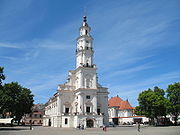
Town Hall, Kaunas
Encyclopedia

Centras (Kaunas)
Centras is an elderate in the city of Kaunas, Lithuania, based on two neighbourhoods of Kaunas - the Old City and the New City. It lies at the confluence of two major Lithuanian rivers, the Nemunas and the Neris....
, Kaunas
Kaunas
Kaunas is the second-largest city in Lithuania and has historically been a leading centre of Lithuanian economic, academic, and cultural life. Kaunas was the biggest city and the center of a powiat in Trakai Voivodeship of the Grand Duchy of Lithuania since 1413. During Russian Empire occupation...
, Lithuania
Lithuania
Lithuania , officially the Republic of Lithuania is a country in Northern Europe, the biggest of the three Baltic states. It is situated along the southeastern shore of the Baltic Sea, whereby to the west lie Sweden and Denmark...
.
The structure dates from the 16th century. It houses a Museum of Ceramics.
History
The construction of Kaunas town hall started in 1542. At first it was a one-storey building with not daubed facade and vaulting cellars. In the 16th century the first floor was build and the eight storey tower was built in the east of the building. The ground floor was adjusted for trading and prison guards, the first floor - for trial, magistrate, treasure, archive and office. Cellars were used to store the goods. The cellars of the tower were used as a prison.In the year 1638 the renaissance
Renaissance
The Renaissance was a cultural movement that spanned roughly the 14th to the 17th century, beginning in Italy in the Late Middle Ages and later spreading to the rest of Europe. The term is also used more loosely to refer to the historical era, but since the changes of the Renaissance were not...
reconstruction was made. In the year 1771 -1775 the second reconstruction was made by architect J. Matekeris. He rebuilt the part of building, which was demolished in the 17th century, replanned the premises and added additional floor to the tower. He decorated the town hall with baroque
Baroque
The Baroque is a period and the style that used exaggerated motion and clear, easily interpreted detail to produce drama, tension, exuberance, and grandeur in sculpture, painting, literature, dance, and music...
and classicism
Classicism
Classicism, in the arts, refers generally to a high regard for classical antiquity, as setting standards for taste which the classicists seek to emulate. The art of classicism typically seeks to be formal and restrained: of the Discobolus Sir Kenneth Clark observed, "if we object to his restraint...
style decorations, rebuilt the pediment and erected there the sculptures of Grand Dukes of Lithuania (they survived only until the 19th century).
In the year 1824 the town hall was used as the premises of the orthodox church and later - ammunition storage.
In the year 1836 the town hall was reconstructed again. The residence for Russian czars was made there.
From the year 1862 and 1869 there was The Kaunas town club, Russian club, firemen office and Russian theatre.
In the year 1869 Kaunas municipality was established in the Town hall. In the year 1944 it was replaced by the archive and in the year 1951 the archive was replaced by Kaunas technical institute.
In 1973 the Wedding Hall (marriage registration office) was opened in the ground and first floor of Town hall. The cellars were used by a Ceramics museum. The same year reconstruction damaged the building a lot.
In the year 2005 the last reconstruction was made, some of damage was eliminated and the Town hall was painted this time not with white color, but with ivory.
Kaunas Town hall is called "The white swan". Today it is used for the wedding ceremonies, official welcome of city guests, signing of agreements and official events

